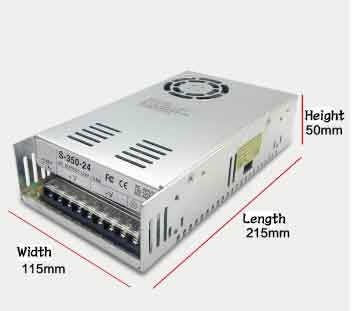- Welcome to Pulse Robot
- +86-23-63207381
- +8613677602178
- sales@pusirobot.com
How to match a suitable power supply to the stepper motor driver?
How to match a suitable power supply to the stepper motor driver?
Stepping motors and drivers need to be used in conjunction with the power supply. When choosing a power supply, first consider the voltage and current requirements in the actual application. This article mainly takes PMC007 series driver as an example to explain how to choose a suitable power supply.
The voltage of the selected power supply
The stepper driver and motor perform well when powered by 12~48V DC voltage. The choice of voltage depends on the required performance and acceptable motor and driver heating (not to trigger the driver's self-over-temperature protection or damage the motor due to overheating). A higher power supply voltage can improve the high-speed performance of the motor, but at the same time it will also increase the heat generation.Therefore, the closer the selected power supply voltage is to the nominal upper limit of the drive, the smaller the operating duty cycle (running and stopping time ratio) allowed by the user, that is, the less time the customer is allowed to run the motor continuously.Otherwise, the drive will overheat and protect itself.
The maximum allowable operating voltage range of PMC007 series drives is 12~48V DC voltage. When the power supply voltage is lower than 12V, the operation of the drive may be unreliable. Do not operate the PMC007 series driver under a DC voltage lower than 12V, otherwise the driver will give a low-voltage alarm, which may stop the work of the driver.
When the driver uses a regulated power supply and the supply voltage is close to 48V, it is recommended to take voltage clamping measures at the power input terminal to avoid the situation where the supply voltage is higher than 48V and the driver overvoltage alarms and stops the driver. When the drive is powered by an unregulated power supply, please ensure that the no-load output voltage value of the power supply is not higher than DC 48V.

The voltage of the selected power supply
PMC007 series stepper motor drivers are used in combination with different stepper motors. Under normal circumstances, the input current of the driver power supply is smaller than the current of the driving motor. This is because the driver itself realizes the energy conversion function.That is, the driver converts a high-voltage, small-current signal into a low-voltage, high-current signal through the power switch.The rated voltage of the motor winding is often very small. When the power supply voltage of the drive is higher than the rated voltage of the motor winding, the power input current required by the drive is smaller.
At the same time, the size of the power input current is also related to the speed and load of the motor during operation. Therefore, for specific applications, users need to perform specific analysis and estimation, or directly consult our pre-sales engineers.
